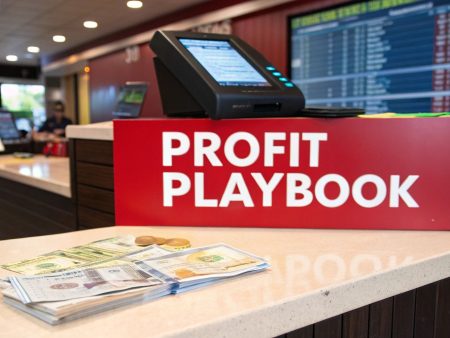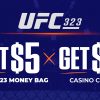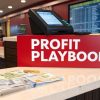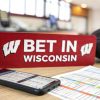Moneyline betting is about as straightforward as it gets in the world of sports wagering. At its core, you're just picking who you think is going to win the game. No complicated point spreads, no victory margins to sweat over—just a simple bet on the final winner.
What Is Moneyline Betting Really
Think about the last time you made a bet with a friend over a game. You probably said something like, "I'll bet you $10 my team beats your team." That's a moneyline bet in its purest form. You're not worried about by how much they win, just that they do.
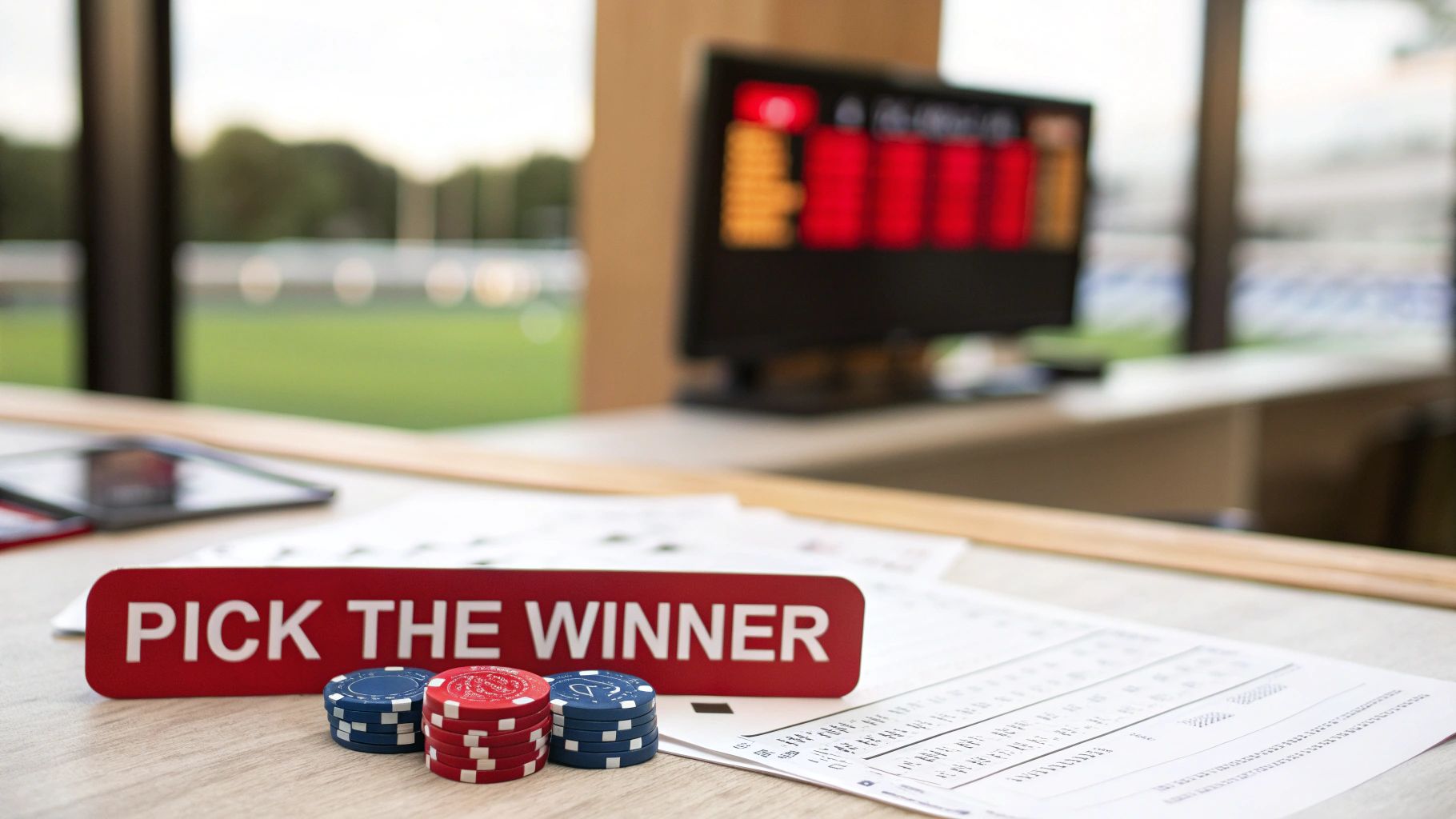
When you log into an offshore sportsbook like Bovada or BetOnline, you'll see a game listing with a number next to each team. That number is the moneyline odd, and it’s the key to the whole thing.
These odds do two crucial jobs: they tell you which team is favored to win and exactly how much you stand to win by backing either side. It's the most fundamental type of sports bet, and its simplicity is a big reason why it’s so popular.
You'll find moneyline bets everywhere, but they're the bread and butter for sports like baseball and hockey. In fact, over 60% of all wagers placed on MLB and NHL games are moneyline bets, mainly because the low-scoring nature of these sports makes point spreads less practical. For a deeper dive into its popularity, ScoresAndStats.com offers some great insights.
Favorites vs. Underdogs Explained
Every moneyline has two sides: the favorite and the underdog. You can tell them apart instantly by the plus (+) or minus (-) sign next to the odds.
- The Favorite: This team has a minus sign (-), like -150. They're expected to win, which means you have to risk more money to win less. The sportsbook is making you pay a premium for picking the safer bet.
- The Underdog: This team has a plus sign (+), like +130. They're the long shot, expected to lose. Because of the higher risk, you get a much bigger payout if they pull off the upset.
At its heart, the moneyline is a balancing act between risk and reward. Backing the favorite is the safer route, but it comes with a smaller payout. Taking a chance on the underdog is riskier, but the potential reward is much greater.
This dynamic is the first thing you need to grasp before placing bets at sites like MyBookie or Sportsbetting.ag. It all boils down to one question: Does the potential payday justify the risk you're taking on?
To make this crystal clear, let's break down what those numbers actually mean in a typical bet.
Moneyline Bet at a Glance
| Bet Component | Favorite Example (-150) | Underdog Example (+130) |
|---|---|---|
| What the Odds Mean | You must bet $150 to win $100. | A $100 bet wins you $130. |
| Total Payout on Win | Your $150 risk + $100 profit = $250. | Your $100 risk + $130 profit = $230. |
| Implied Probability | The odds imply a 60% chance of winning. | The odds imply a 43.5% chance of winning. |
| Risk vs. Reward | Low reward for higher risk (safer bet). | High reward for lower risk (riskier bet). |
As you can see, the odds directly reflect the sportsbook's confidence in each team. Your job is to decide whether you agree with their assessment or if you see an opportunity they might have missed.
How to Read Moneyline Odds Like a Pro
When you first pull up a sportsbook like MyBookie or BetUS, all those numbers with plus (+) and minus (-) signs can look like a foreign language. But they're actually telling a very simple story about risk and reward. This is called American odds formatting, and once you get the hang of it, you'll know exactly what you're getting into with every bet.

Just think of 100 as the magic number here. Every calculation revolves around either betting $100 or winning $100. It's a simple standard that makes it easy to compare odds across different games and sportsbooks, whether you're on Bovada or BetAnything.
Let's break down the two sides of every moneyline bet.
Understanding the Minus Sign Favorites
The minus sign (-) is your signal for the favorite—the team the sportsbook expects to win. Since they're the more likely winner, you have to risk more to make a profit, meaning the payout is smaller. The number you see next to the minus sign is exactly how much you need to bet to win $100.
For example, let's say the Los Angeles Lakers are listed at -150 odds on Bookmaker.eu:
- What it means: You have to wager $150 to walk away with a $100 profit.
- Total Payout: If the Lakers get the job done, you get your original $150 stake back plus your $100 in winnings, for a grand total of $250.
This setup rewards you less for taking what's considered the "safer" pick. The bigger that negative number gets (like -300 or -400), the heavier the favorite, and the more cash you have to put on the line for that same $100 return.
Understanding the Plus Sign Underdogs
On the flip side, the plus sign (+) always points to the underdog—the team not expected to win. To make that riskier bet more appealing, sportsbooks offer a much better potential payout. The number next to the plus sign tells you how much profit you'll pocket from a $100 wager.
Let's imagine the Miami Heat are facing the Lakers and have odds of +130 at Xbet:
- What it means: A $100 bet will score you a $130 profit.
- Total Payout: If the Heat pull off the upset, you get your $100 stake back plus that sweet $130 profit, for a total of $230.
You're taking a bigger gamble, so the reward is higher. Simple as that. For a deeper dive into all the nuances, feel free to read our complete guide on how to read betting odds.
Key Takeaway: The minus sign (-) shows what you risk to win $100. The plus sign (+) shows what you win for every $100 you risk.
Calculating Your Payouts for Any Bet
Reading the odds is one skill, but actually turning those numbers into dollars and cents is where the rubber meets the road. Getting a feel for how to quickly calculate your potential winnings is essential for managing your bankroll and sniffing out good value at offshore sportsbooks like Sportsbetting.ag or Bookmaker.eu.
The good news is the math isn't complicated at all. There are a couple of simple formulas—one for favorites and one for underdogs—that will have you sizing up bets in seconds. Once you get these down, you'll know the exact risk and reward before you ever hit that "place bet" button.
The Formula for Favorites
When you’re backing a favorite—the team with the minus (-) sign—you're always risking more than you stand to win. That's the price you pay for picking the team more likely to come out on top.
Favorite Payout Formula: (Wager / (Odds / 100)) = Profit
Let's plug in a $50 wager to see how this plays out with a few common lines you might see on a site like BetUS:
- Odds of -120: ($50 / (120 / 100)) = ($50 / 1.2) = $41.67 Profit. Your total return would be $91.67.
- Odds of -180: ($50 / (180 / 100)) = ($50 / 1.8) = $27.78 Profit. Your total return would be $77.78.
- Odds of -250: ($50 / (250 / 100)) = ($50 / 2.5) = $20.00 Profit. Your total return would be $70.00.
You can see how your potential profit gets smaller as the odds get bigger. That's just how it works when you're laying the chalk.
The Formula for Underdogs
Figuring out the payout on an underdog is even more straightforward. Since you're taking a bigger risk on the team expected to lose, the potential reward is much sweeter.
Underdog Payout Formula: (Wager * (Odds / 100)) = Profit
Again, let’s stick with that same $50 wager and see what happens when we back a few longshots at a book like Bovada:
- Odds of +110: ($50 * (110 / 100)) = ($50 * 1.1) = $55.00 Profit. Your total return would be $105.00.
- Odds of +175: ($50 * (175 / 100)) = ($50 * 1.75) = $87.50 Profit. Your total return would be $137.50.
- Odds of +220: ($50 * (220 / 100)) = ($50 * 2.2) = $110.00 Profit. Your total return would be $160.00.
The profit scales up fast, giving you a nice payday for calling the upset.
To make it even clearer, here's a side-by-side look at how a simple $50 bet performs across a range of odds.
Sample Moneyline Payout Calculations
| Team Type | American Odds | $50 Wager Profit Calculation | Total Payout |
|---|---|---|---|
| Heavy Favorite | -250 | ($50 / (250 / 100)) = $20.00 | $70.00 |
| Slight Favorite | -120 | ($50 / (120 / 100)) = $41.67 | $91.67 |
| Slight Underdog | +110 | ($50 * (110 / 100)) = $55.00 | $105.00 |
| Heavy Underdog | +220 | ($50 * (220 / 100)) = $110.00 | $160.00 |
As you can see, the risk-reward dynamic shifts dramatically depending on which side you take. Committing these two simple formulas to memory is one of the first and most important steps to becoming a sharper, more confident sports bettor.
Finding Value with Implied Probability and Vig
If you want to get a real edge in moneyline betting, you have to move beyond just picking who you think will win or lose. The sharpest bettors out there focus on two concepts that separate them from the casual crowd: implied probability and vigorish (often just called the "vig").
Mastering these two ideas is the key to unlocking actual value when you're scanning the lines at sportsbooks like Xbet and BetAnything.
What Is Implied Probability?
Think of implied probability as a way to translate American odds into a simple percentage. It essentially tells you what the sportsbook thinks a team's chances of winning are. This is how you pull back the curtain and see if the book's expectation lines up with your own homework.
Every moneyline has this win percentage baked right in. When you see the Dallas Cowboys listed at -150, that's not just a random number—it implies they have a 60% chance to win the game. If their opponent is sitting at +130, the odds are suggesting they have a 43.5% shot at an upset.
Wait, do the math. 60% + 43.5% = 103.5%. That extra 3.5% isn't a typo. It’s the sportsbook's built-in advantage, which brings us to our next point.
Key Takeaway: Implied probability helps you answer one crucial question: "Are this team's actual chances of winning better than what the odds are telling me?" If your answer is yes, you've just found yourself a value bet.
This infographic breaks down the simple formulas used to calculate payouts, which is the first step before you can figure out the implied probability.

Once you get how payouts work, you can start to see how sportsbooks build their edge directly into the odds.
Uncovering the Vig or Juice
That extra percentage that pushes the total over 100%? That’s the vigorish, or "vig." You’ll also hear old-school bettors call it the "juice." It's basically a small commission the sportsbook charges for the service of taking your bet.
It's how sites like Bookmaker.eu and BUSR guarantee they turn a profit in the long run, no matter which team wins on a given Sunday. For example, a team with -200 odds has an implied probability of about 66.7%. In a perfectly balanced book, the sum of all outcomes will always be more than 100%, and that difference is the bookie's margin.
Typically, the vig on moneyline bets is around 4–5%. This means you have to win more often than not (usually over 52% of the time) just to break even. You can learn more about how odds are constructed on Wikipedia.
This is why shopping for the best lines is so critical. By comparing odds across different sportsbooks, you can find the lowest vig and give yourself a better chance to win. Check out our guide on sports betting odds comparison to see how even small differences in juice can make a huge impact on your bankroll over time. Betting smarter starts right here—by finding the house edge and doing everything you can to shrink it.
When to Choose Moneyline Over Point Spreads
Knowing what is moneyline betting is one thing, but the real art is knowing when to use it. While point spreads are king in high-scoring games like football and basketball, the moneyline is often the sharper, more strategic play in certain situations. Picking the right bet type is a skill in itself.
The clearest case for a moneyline bet is in low-scoring sports. Think baseball (MLB) and hockey (NHL), where the final score often comes down to just one run or a single goal. In these tight contests, betting on a team to win by a specific margin is a total crapshoot. The moneyline cuts through the noise: you just need your team to win, period. It doesn't matter if it's by a hair in overtime.

This approach saves you from the agony of a "bad beat," where your team wins the game but doesn't cover the spread—a uniquely painful experience for any bettor. To really see the difference, it helps in understanding point spreads in sports betting and why their logic just doesn't fit these nail-biter games.
Betting on Small Favorites
In sports like the NFL or NBA, the choice gets a bit more interesting. One of my favorite spots to use the moneyline is when I'm backing a small favorite.
Picture this: you're browsing BUSR and see the Kansas City Chiefs favored by only -2.5 points. If you lay the points, you need them to win by a field goal or more. A heart-stopping 24-23 victory would mean your point spread ticket is worthless. By taking the moneyline instead (at odds of, say, -140), you're trading a bigger payout for a much safer bet. All you need is a Chiefs win, and you cash. It’s a great way to avoid the frustration of losing on a winning team.
Backing a Live Underdog
On the flip side, the moneyline is your best friend when you have a gut feeling that an underdog is going to pull off the upset. If you believe the dog has a real chance to win outright, why would you just take them to cover the spread?
Betting an underdog on the point spread might get you odds around -110. But if you take that same team on the moneyline at a site like Bet105, you could be looking at a huge payout of +200, +250, or even more. When your homework points to an upset, the moneyline is how you get properly rewarded for that bold call. It turns a good read into a fantastic payday.
The Good, The Bad, and The Moneyline
Like any bet, the moneyline has its moments to shine and its moments to avoid. It’s not a one-size-fits-all magic bullet, so getting a handle on its strengths and weaknesses is key before you head over to sportsbooks like Cosmobet or Bovada.
The biggest draw? It’s dead simple. You’re just picking a winner. That’s it. There’s no point spread to worry about or any other complicated rules. It's the most straightforward bet you can make.
This simplicity leads to another huge plus: the thrill of hitting a big underdog. Nailing an upset pick can turn a few bucks into a massive payout, delivering a kind of excitement that a point spread bet just can't replicate.
Advantages of Moneyline Wagering
- Beautifully Simple: It doesn’t get any easier than this. You pick a team to win, and if they do, you cash your ticket.
- Massive Payout Potential: If you have a knack for sniffing out upsets, backing a big underdog can lead to some seriously impressive profits.
- Always an Option: Moneyline odds are everywhere. You'll find them for just about every game in every major sport at top sites like Bookmaker.eu and BetUS.
But it’s not all sunshine and underdog stories. The moneyline’s dark side shows up when you want to bet on a heavy favorite. To win even a little bit of money, you have to risk a whole lot more.
For instance, betting on a -400 favorite means you have to put up $400 just to make a $100 profit. One shocking upset can completely erase the winnings from several of your previous successful bets, making it a dicey way to grow your bankroll.
Disadvantages of Moneyline Wagering
- Tiny Returns on Favorites: Wagering on the big dogs offers pretty slim profits. You're laying a lot of wood for a small return.
- High Risk for Small Gains: That single upset loss when you've backed a heavy favorite can be devastating to your bankroll, wiping out your hard-earned wins.
- Questionable Value: Sometimes, the odds on a lopsided favorite are so juiced that there’s almost no value left, even if victory seems like a sure thing.
Ultimately, choosing to place a moneyline bet is a balancing act. It's fantastic for its simplicity and the high-reward potential on long shots, but it requires serious discipline and careful bankroll management when you’re tempted by those heavy favorites.
Got Questions? We've Got Answers
Even after you get the hang of moneyline betting, some weird terms and situations can pop up that might throw you for a loop. Let's clear up some of the most common questions you'll run into at your favorite offshore sportsbooks.
What Does PK or Pick’em Mean?
Every now and then, you'll be browsing the lines on a site like MyBookie or BetUS and see "PK" or "pick'em" instead of the usual odds. Don't panic. This just means the sportsbook sees the matchup as a total toss-up.
Essentially, the two teams are so evenly matched that there's no clear favorite or underdog. In a pick'em, the point spread is zero, and you'll typically see the odds for both teams sitting right around -110. Your job is as simple as it gets: just pick the team you think will win the game, straight up.
How Is a Push Handled?
A "push" is just a fancy term for a tie. When your bet ends in a push, your original stake gets refunded, and it’s like the bet never happened. You didn't win, but you didn't lose either.
This doesn't happen much in sports like football or basketball because of overtime rules. But in soccer, where draws are a regular part of the game, it's something you'll see often. If you place a standard moneyline bet (Team A to win vs. Team B to win) and the match ends in a tie, sportsbooks like BetOnline or Sportsbetting.ag will grade it as a push and send your money right back to your account.
Just a heads up: for soccer, many sportsbooks now offer a three-way moneyline that includes the draw as its own betting option. If you bet on that kind of line, a tie is a specific outcome you can wager on, which eliminates the possibility of a push.
Can You Parlay Moneyline Bets?
You bet. In fact, it's one of the most popular ways to chase a big payday. A parlay is a single wager that bundles two or more individual bets (called "legs") together.
Here's the catch: to win your parlay, every single one of your picks has to hit. If even one leg loses, the whole ticket is toast.
So, why bother? The payout potential is huge. At a site like Bovada, you could combine the Green Bay Packers moneyline with the Los Angeles Lakers moneyline. When you package bets like this, the odds multiply, which can turn a small wager into a massive win. The risk is definitely higher, but that high-reward thrill is what makes parlays so tempting.
A common strategy is to string a few heavy moneyline favorites together in a parlay to get a better return. Or, if you're feeling bold, tossing an underdog into the mix can really send the potential profit sky-high.
Now that you've got a handle on the ins and outs of moneyline betting, you’re ready to jump into the action. To find the best odds and compare welcome bonuses from top-rated offshore sportsbooks, check out the expert reviews at USASportsbookList. Visit us today at https://usasportsbooklist.com and place your first winning wager.
